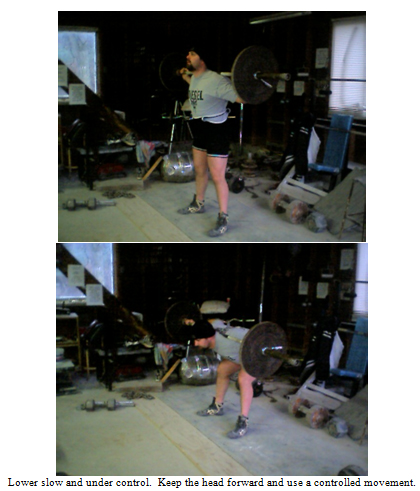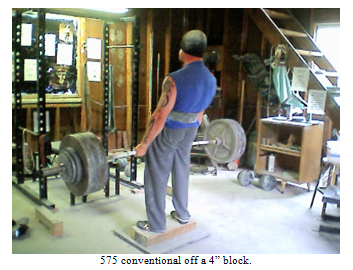
Training
So how does one build a strong deadlift? What training techniques work? What doesn't work? Most importantly, how often does one deadlift?
Although I am fairly young in years, I am still "old school" when it comes to training the deadlift. I am a firm believer that you need to pull at least once a week if you are going to consistently add weight to the deadlift. However, I also believe in using many variations of the deadlift, as well as many assistance exercises, in order to make the deadlift skyrocket!
Let's start with some basic assistance exercises. The first I want to mention is the barbell good morning. In my opinion, nothing is better for strengthening the structures of the lower back for big pulls. This exercise can also be extremely risky if you are not careful. Beginners should start out light, with an empty bar, and strive to add only 5-pounds a week. It is a risky exercise, and you do it at your own risk. To me, the benefits I see in my deadlift, and squat, far outweigh the risks.
Start with the bar on your back like you would if you were performing the barbell back squat. Use the same stance width you use when squatting or deadlifting. Keep the back tight and push the butt back as you lower the weight. Take the weight down to about waist height, keeping the back tight the entire time. No rounding! Your weight should be on your heals and your butt should be back. The stress should be felt on the low back as well as the hamstrings. No flex the back and hamstrings to return the weight to the standing position. Throw your ego out the door! Go light, strengthen the back, and reap the benefits of this great exercise!

The next assistance exercises are for the hips. I am a firm believer of strengthening the hips as much as possible. As the hips get stronger, your sumo and conventional pull will increase. As a matter of fact, I believe in this theory so much that I train all my pulls sumo style until I am two to three weeks out of a contest. Only then do I switch to conventional. With that, one of the best ways to strengthen the hips is to pull sumo! Concentrate hard on pushing the feet into the platform and spreading the floor.
A second way that is tremendous in strengthening the hips is the barbell box squat. Use a wide stance and squat onto a box that is a little below parallel. Lower slow to the box, do not bounce or slam onto it! Once on the box, relax the hip flexors then flex them hard to pop off the box and lockout the weight. Drive out on legs the entire time, lowering and lifting. Spread the floor with the feet hard!

To learn how to box squat properly, visit www.elitefts.com and read the articles on box squatting. Reps, sets, weight, etc. are all explained in great detail.
A third exercise I like to use on my hips is the bottom-up chain suspended squat. This movement requires a cage and some heavy-duty chains. I set the cage pins up so when the chains are attached, the bar is below parallel.

I then wiggle under the bar, get set-up as straight as possible, then concentrate on driving my feet into the ground and lifting the weight with my hips only.

Keep your back straight the whole time and use the hips. Drive out hard with those feet. A quick word on why I use the chains instead of the cage pins: the chains allow me to use my proper form as opposed to being locked onto the pins. Also, with the chains, I can really wiggle under the bar, as it is free to move with me.
Along with these assistance exercises, I also pull at least once a week. This is a constantly changing process; sometimes I may do regular pulls from the ground, sometimes I will do a rack pull, sometimes I will go off a box, and sometimes I will do a specialty lift such as adding bands or chains.
One movement I really like to do is the rack pull. Put the bar in the cage at your sticking point. For me, this is about 14" off the ground. I tend to slow down at this point and it causes my deadlift to grind to a halt. Experiment to find your sticking point, but you can do these from as low as 1" from the ground and as high as above the knees. Everything about your form stays identical as it would to pulling off the ground. I do singles and triples with these, and I always use a semi-sumo style.

Another great movement in building deadlift speed is the band deadlift. Loop a couple of Jumpstretch© bands over the bar like so:

Now pull like you normally would. Use perfect form and make sure to pull with speed. If you don't-you won't make it to lockout! Use 60-80% of your max, and then add bands of your choice. Do triples, as many as ten sets.

If you have access to chains, you can use them as well. Just drape them over the bar, then go to it. More chains = more weight at lockout!

Another great way to overload the top for a strong lockout is to use dumbbells. Beware, dumbbells are much more intense then chains or bands because the weight gain is not gradual, but rather instant. Chain some dumbbells to each side of the bar like so:

Make sure to measure the chain and have the dumbbells kicking in right at your sticking point. This works okay off the ground, but even better in the cage, as you wont have to worry about hitting the dumbbells on the way down. Use this for singles work.

If you have access to the Jumpstretch© bands, you can also do the reverse-band deadlift. I love this lift as it really strengthens the lockout portion of the deadlift. Simply attach the bands of your choice to the cage pins at a desired height, or the top of the cage. The higher the bands are attached, the more they will help off the ground. Then attach the bands to the bar. You will notice, depending on what bands you use, you will need a certain weight just to keep the bar on the ground. This weight can be used as the amount the bands are actually de-loading from the bottom.

With all this talk about lockout strength, how does one strengthen the bottom of the lift? Nothing is better then the deadlift off a box. Stand on a box that allows the bar to almost touch the tops of the feet. Keep your form the same as you would if pulling a regular deadlift, only now you must get the hips much deeper to initiate the pull. Everything stays the same! You will find you will have to use much less weight to perform this lift.


 12:52 AM
12:52 AM
 SS.A
SS.A


0 comments:
Post a Comment